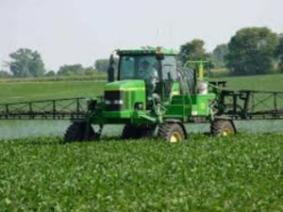by: Erdal Ozkan, OSU

Whenever I give a presentation about the need to calibrate a sprayer and how to do it, there is always someone asking me this same question: “I have a rate controller in the cab that regulates the flow rate of the sprayer regardless of the changes in sprayer ground speed. I just enter the gallons per acre application rate, and the controller does the rest, just like a cruise control in a car. So, should I still calibrate the sprayer? The answer is, Yes, a calibration should be done. Although the rate controllers do an excellent job with regulating the flow rate of nozzles to keep the application rate constant regardless of the changes in travel speed, a manual calibration at least once a year is needed for two reasons: 1) to ensure the rate controller is functioning properly, 2) the rate controller is not forced to operate outside the pressure operating range for the nozzles on the sprayer boom. Let me elaborate on both points I made and share with you the reasons why a manual calibration of a sprayer is a good idea.
- f you are stopped by a police officer for speeding, telling the police officer that the car was in cruise control set to the speed limit will not get you out of getting a ticket. Cruise controls go bad, so will the rate controllers. That is why it is best to manually check the flow rate of nozzles to make sure the gallons per acre application rate you enter on the controller matches the gallons per acre rate provided by the nozzles.
- Your controller may be in good shape, but if the ground speed sensor is giving inaccurate data to the controller, it will not work accurately. For example, if the speed sensor works based on revolutions of the tractor wheels, the ground speed determined may not be accurate, because of the slippage that may occur under some ground conditions. Even the tire pressure being off just a few psi may change the tire revolutions per minute leading to erroneous travel speed readings.
- Unfortunately, most standard electronic controllers cannot detect flow rate changes on each nozzle on the boom. So, if a nozzle is plugged, or extremely worn out, the rate controller cannot warn us about these problems that happen all the time. It will still try to maintain the constant application rate by changing the system pressure and force other nozzles on the boom to spray less or more to overcome the problems with one or several nozzles on the spray boom.
- Finally, controllers don’t show changes in spray patterns that may happen when a nozzle is defective, plugged, or worn-out. If several of the nozzles are not maintaining the proper spray angle the proper overlap between adjacent spray patterns cannot be established. This will result in untreated areas and streaks under the boom, or some areas may receive excessive deposition of the pesticides applied. So, we will have to continue manually checking the flow rate of the nozzles, and visually observing the changes in spray patterns until the technology is developed to do these observations remotely, and on-the-go.
- As you know, to achieve best results from pesticides, the application rate, as well as the droplet size must remain relatively unchanged during the entire spraying. When sprayer speed goes up, to maintain the pre-set application rate, the controller requires the system pressure to go up to increase the nozzle flow rate. This, unfortunately, results in more drift-prone droplets coming out of the nozzle, especially if the nozzle used is designed for low application rates within the recommended pressure ranges. Conversely, when the sprayer slows down, the opposite happens: the controller forces the system to lower the pressure, in order to reduce flow rate of nozzles. This will result in production of larger than the desired size of droplets, leading to inadequate coverage. If you are spraying Dicamba or 2,4-D herbicides, you need to pay even more attention to operation of rate controllers. As you know, only a small number of nozzles at specific ranges of pressure can be used to spray these products. Significant changes in ground speed may force the rate controller to make significant changes in spray pressure that may be outside the allowable legal pressure range required to spray these herbicides. Without you realizing it, you may find yourself in violation of the label. Make sure the nozzle size selected will allow the controllers to make necessary changes in the flow rates while still staying within a safe, applicable, and allowable pressure range.
How to calibrate a sprayer?
It usually doesn’t take more than 30 minutes to calibrate a sprayer, and only three things are needed: a watch or smart phone to record the time when measuring the nozzle flow rate or the travel speed, a measuring tape, and a jar graduated in ounces. Please look at the Ohio State University Extension publication FABE-520 for an easy method to calibrate a boom-type sprayer. Here is the URL for this publication:
